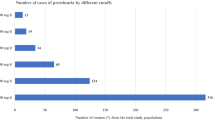Abstract
We asked, is uric acid as effective as proteinuria at identifying perinatal risk in high-risk women with gestational hypertension? Uric acid was measured in samples obtained ≈4.6 weeks predelivery in 259 women with prior preeclampsia from the National Institute of Child Health and Human Development network study of low-dose aspirin to prevent preeclampsia. Participants were grouped according to the presence/absence of gestational hypertension (H), proteinuria (P), and hyperuricemia (U). Adverse perinatal outcomes were not different between H or U and women with normal values (normal blood pressure, urinary protein, and uric acid [NNN]). Preterm birth was greater in hypertension and proteinuria (HP) and hypertension and hyperuricemia (HU) compared to NNN (relative risk [RR] = 2.4, P = .03 and 3.8, P < .01), respectively. In addition, in HU women, delivery was earlier (36.6 ± 3.4 vs 38.4 ± 2.3 weeks, P < .001) and small for gestational age infants <fifth centile more frequent (RR = 8.2, P = .01) compared to NNN women. This study sought to determine if uric acid is as effective as proteinuria at identifying perinatal risk in high-risk women with gestational hypertension. Our results suggest that hyperuricemia is at least as accurate as proteinuria at identifying perinatal risk in high-risk women with gestational hypertension.
Similar content being viewed by others
References
American College of Obstetricians and Gynecologiests Task Force on Hypertension in Pregnancy. Hypertens Pregnancy. Washington, DC: The American College of Obstetricians and Gynecologists; 2013.
Hutcheon JA, Lisonkova S, Joseph KS. Epidemiology of preeclampsia and the other hypertensive disorders of pregnancy. Best Pract Res Clin Obstet Gynaecol. 2011;25(4):391–403.
Roberts JM, Bodnar LM, Lain KY, et al. Uric acid is as important as proteinuria in identifying fetal risk in women with gestational hypertension. Hypertension. 2005;46(6):1263–1269.
Hawkins TL, Roberts JM, Mangos GJ, Davis GK, Roberts LM, Brown MA. Plasma uric acid remains a marker of poor outcome in hypertensive pregnancy: a retrospective cohort study. BJOG. 2012;119(4):484–492.
Thangaratinam S, Coomarasamy A, O’Mahony F, et al. Estimation of proteinuria as a predictor of complications of preeclampsia: a systematic review. BMC Med. 2009;7:10.
Bainbridge SA, Roberts JM. Uric acid as a pathogenic factor in preeclampsia. Placenta. 2008;29(suppl A):S67–S72.
Conrad KP, Gaber LW, Lindheimer MD. The kidney in normal pregnancy and preeclamsia. In: Lindheimer MD, Roberts JM, Cunningham FG, eds. Chesley’s Hypertensive Disorders in Pregnancy. San Diego, CA: Academic Press, Elsevier; 2009:297–334.
Powers RW, Bodnar LM, Ness RB, et al. Uric acid concentrations in early pregnancy among preeclamptic women with gestational hyperuricemia at delivery. Am J Obstet Gynecol. 2006;194(1):160e.1–160.e8.
Caritis S, Sibai B, Hauth J, et al. Low-dose aspirin to prevent preeclampsia in women at high risk. National Institute of Child Health and Human Development Network of Maternal-Fetal Medicine Units. N Engl J Med. 1998;338(11):701–705.
Lind T, Godfrey KA, Otun H, Philips PR. Changes in serum uric acid concentrations during normal pregnancy. Br J Obstet Gynaecol. 1984;91(2):128–132.
Alexander GR, Kogan MD, Himes JH. 1994–1996 U.S. singleton birth weight percentiles for gestational age by race, Hispanic origin, and gender. Matern Child Health J. 1999;3(4):225–231.
Thangaratinam S, Ismail KM, Sharp S, Coomarasamy A, Khan KS; Tests in Prediction of Pre-eclampsia Severity review group. Accuracy of serum uric acid in predicting complications of preeclampsia: a systematic review. BJOG. 2006;113(4):369–378.
Myatt L, Redman CW, Staff AC, et al. Strategy for standardization of preeclampsia research study design. Hypertension. 2014;63(6): 1293–1301.
Lindheimer MD, Kanter D. Interpreting abnormal proteinuria in pregnancy: the need for a more pathophysiological approach. Obstet Gynecol. 2010;115(2 pt 1):365–375.
Cote AM, Firoz T, Mattman A, Lam EM, von Dadelszen P, Magee LA. The 24-hour urine collection: gold standard or historical practice? Am J Obstet Gynecol. 2008;199(6):625 e621–626.
Rothman KJ. No adjustments are needed for multiple comparisons. Epidemiology. 1990;1(1):43–46.
Author information
Authors and Affiliations
Corresponding author
Rights and permissions
About this article
Cite this article
Schmella, M.J., Clifton, R.G., Althouse, A.D. et al. Uric Acid Determination in Gestational Hypertension: Is it as Effective a Delineator of Risk as Proteinuria in High-Risk Women?. Reprod. Sci. 22, 1212–1219 (2015). https://doi.org/10.1177/1933719115572477
Published:
Issue Date:
DOI: https://doi.org/10.1177/1933719115572477




